When you sit in someone else’s restaurant, you probably do not look at the dining table twice unless it is unique. However, when it comes to your own restaurant, the type of dining table you choose can make or break the setting you are trying to create.
Depending on the restaurant you own, you must create an ambiance that elevates both the atmosphere and the food. Your choice of dining table plays an integral role in this process.
Why a Dining Table Is More Than Just a Functional Piece of Furniture
When patrons dine at your restaurant, they need a place to sit and eat. Your dining tables should invite them to do just that. Dining tables within a restaurant provide so much more than just functionality.
When you choose your tables well, they can evoke warmth and intimacy. They can form part of a welcoming, relaxing environment that moves patrons to linger longer and savor their meals.
The opposite is also true. When dining tables are not suited to your restaurant space, guests will feel uncomfortable or cramped. This setting will never entice patrons to stay and enjoy dessert after dinner or cocktails before lunch.
What to Consider When Choosing the Perfect Dining Table
So, how do you choose the right dining table for your restaurant? There are several factors to consider, including:
- The concept and design of your restaurant
- The size and shape of your dining area
- Material and aesthetics, including thickness and finish
- Table height, comfort aspect, and seating arrangement
- Cost and maintenance
You must evaluate how these factors will impact the dining experience for your customers and budget.
Understanding Your Restaurant's Concept
Your ultimate dining table choice depends on your restaurant's identity. If you own a bistro, you want something durable but not too casual. If your restaurant is about fine dining, your tables must reflect elegance and sophistication.
Casual eateries or fast-food places need tables that promote comfort and sociability. At the same time, each table’s design, material, color, and finish must complement the restaurant’s overall look.
Matching Your Dining Table Choice With Your Restaurant Design
To ensure your dining tables fit your restaurant design, you must look at how they ‘interact’ with your wall and floor colors. You must also determine what your chosen tables look like in different light settings (day and night). Lastly, your tables must match the other furniture pieces.
For example, premium-grade stainless steel base tables with solid wood, copper, or metal surfaces are great for most luxury restaurants or even hotels. These typically come ready for configuration so you can adjust the widths, depths, and heights to suit your space.
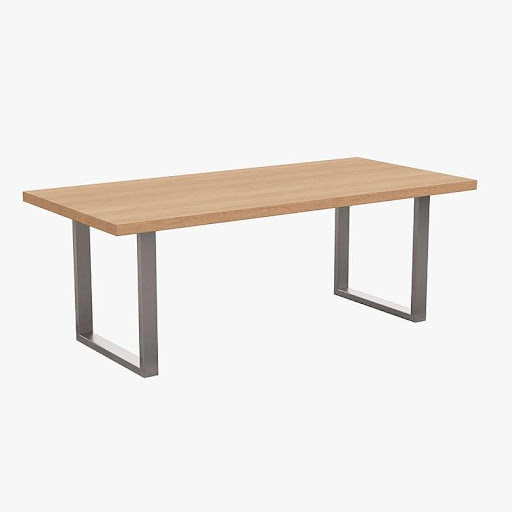
Wood Surface
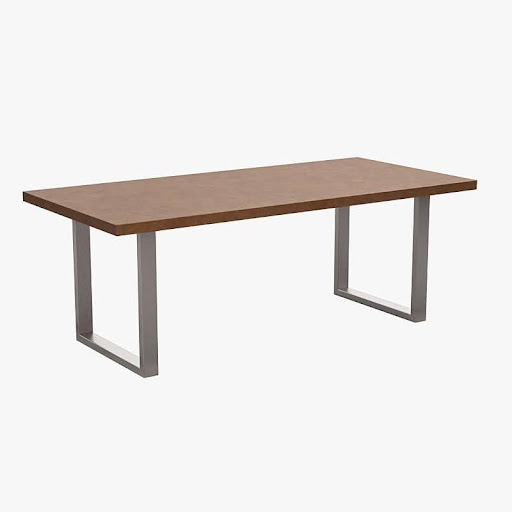
Copper Surface
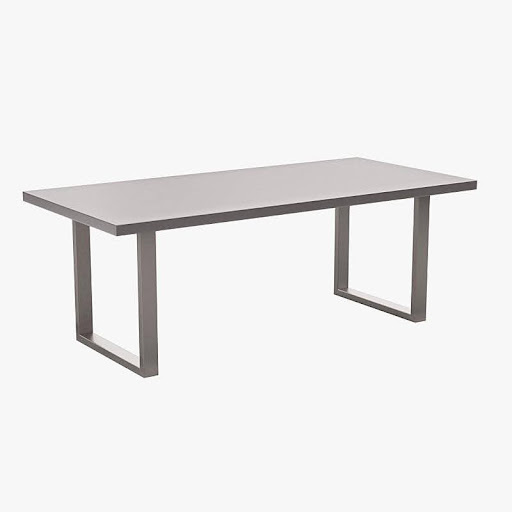
Natural Stainless Steel Surface
Other factors to consider include:
- Durability
- Easy cleaning
- Movability
Size and Shape
Once you know what you want your dining tables to look like, you should measure your dining space to see if they will fit properly. Consider the room's dimensions, including the shape and inevitable obstacles like columns or doorways.
You can plan your table layout if you know how much space you have to work with. Remember that the number of guests your dining area can accommodate will also impact table size and number. Smaller restaurants typically group tables in singles, twos, and fours. Larger venues need more options, such as longer tables or the option to link them seamlessly.
It is also important to create enough space between tables and table groupings so guests do not struggle to get in and out of their seats.
Table Shapes
Generally speaking, rectangular tables are the most versatile type. They can maximize dining space and work incredibly well for restaurants with a high turnover rate.
Rectangular tables can also easily create a luxury or informal dining experience, depending on their use.
Material Matters
As mentioned, the material you choose for your tables is crucial because it impacts their longevity, appearance, and the level of maintenance required. Rectangular dining tables come with a wide range of material options.
Ideally, you want a solid base made of heavy-duty stainless steel. Most heavy bases are finished with a long-lasting powder coating to maintain their aesthetic.
You can choose from several tabletops (surfaces) to complement this type of foundation. These include:
Metal
Metal surfaces can withstand high temperatures and are less likely to suffer damage. They are also highly resistant to warping, scratches, and dents. Metal tabletops are an excellent choice for a modern restaurant look and are easy to clean.
Stainless steel is particularly popular because of its hygienic properties.
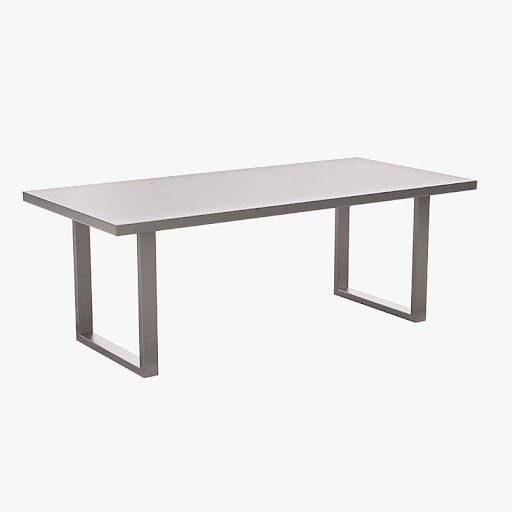
Brushed Stainless Steel Surface
Solid Surface
Solid surfaces do not absorb liquids, which makes them durable and easy to maintain. Most solid tabletops have non-visible joints, which makes them hygienic (no germ buildup).
If you choose a solid-surface dining table, you also have many options, including granular, waterstone, and vein.
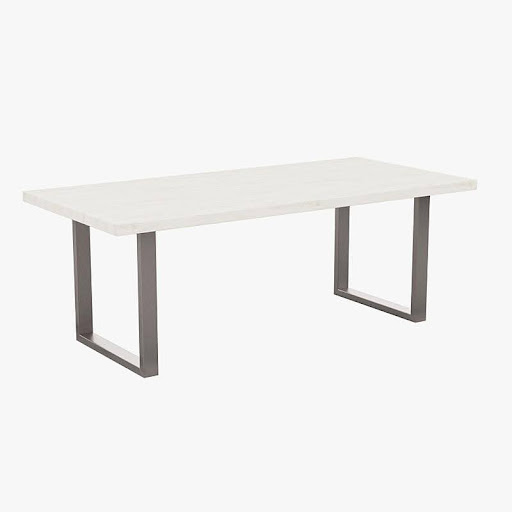
White Waterstone Surface
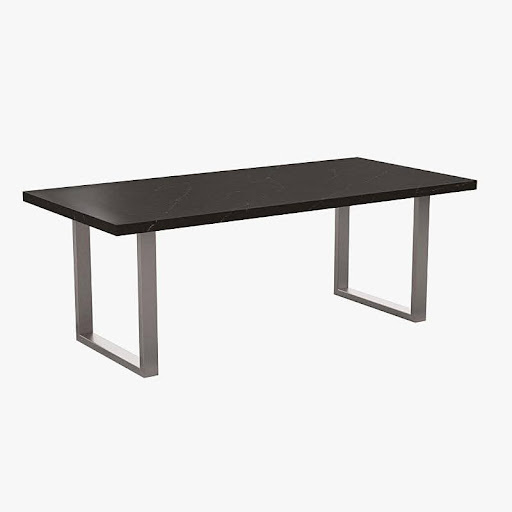
Grey Vein Surface
Weathered Copper
Weathered copper tabletops may be a good option if your restaurant has indoor and outdoor dining areas. These surfaces look natural and last very long. They require minimal maintenance and immediately draw a crowd because of their unique look.
Also, considering that you want your guests’ restaurant experience to be safe and hygienic, copper offers antimicrobial and antibacterial properties.
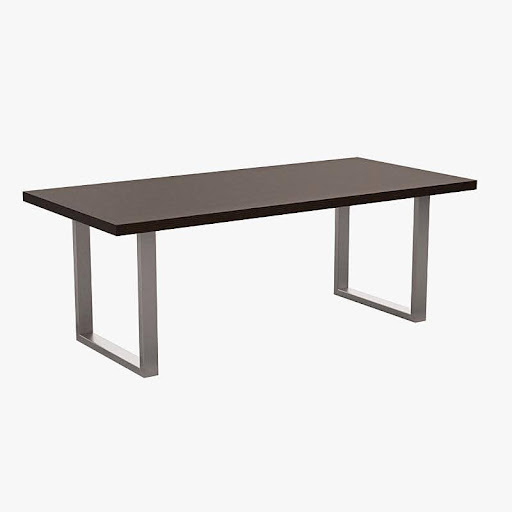
Weathered Copper Surface
Wood
Wood is the number one choice for most restaurant owners who want to create a warm and elegant dining space. Wood is known for being timelessly appealing, and there are multiple wood surfaces to choose from.
Moreover, the different grain patterns and colors of wood surfaces will suit even the most unique restaurant. It is important to remember that wood tables should be used indoors if you want them to maintain their integrity and look for longer.
Some wood textures and grains include maple, oak, walnut, and teak.
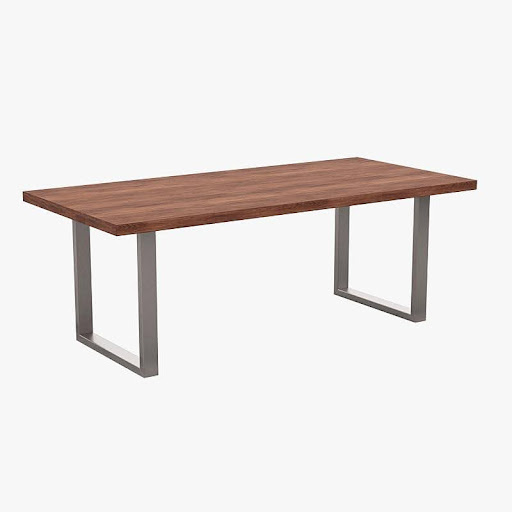
Walnut Wood Surface

Teak Wood Surface
Other surface options that can help create the right atmosphere and look for your restaurant include brass and stone, such as marble or granite. Both are typically good for indoor use, but it is important to note that marble and granite are prone to chipping and other damage.
Wood tables are the perfect complement if you want to create a rustic space. Steel, copper, or brass tables elevate any modern setting, while granite may help exude a luxury feel.
Other Table Surface Considerations
The surface you select for your dining tables matters for more than just looks. You need to consider the thickness of the surface to ensure stability and prevent warping. Tabletops should be able to withstand staining and heat. When these boxes are ticked, you can look at surface finishes that work best with your dining space.
Table Design Makes a Difference in the Dining Experience
The aesthetic of your dining tables will only get you so far. Dining tables should be beautiful and functional. This means you must consider the height and depth of your tables to ensure comfort for your guests.
Tables that are too low will likely cause most guests to hunch while eating. On the other hand, if your tables are too high, guests with shorter legs will find them very uncomfortable.
Moreover, wide table legs tend to obstruct legroom, while too-narrow legs may make the table unstable.
To prevent these issues, you must choose easy-to-adjust dining tables. Your tables should have a strong frame that connects well to their surfaces. Table bases should be heavy-duty and constructed from durable materials.
Elevating Great Dining Tables
You can elevate your dining tables even further by adding custom accessories. Modern restaurants cater to their guests’ reliance on electronics. If possible, add small, unobtrusive charging stations below or above your dining tables so guests can keep their phones charged.
Your table design will also play a role here. You do not want your guests to crawl under the table to reach the charging station, which should be easily accessible.
Cost and Maintenance
Choosing the perfect dining table for your restaurant is also a financial decision. After all, you likely have a budget to stick to, and the type of table you select must fit into this budget.
The factors that affect the cost of dining tables include:
- Material
- Size
- Design
High-end materials will inevitably cost more than cheaper options such as laminate or engineered wood. If you go with solid wood, stainless steel, or waterstone, you pay for quality materials that will last a long time.
In general, larger tables will also cost more because of the increased materials used. However, you can purchase regular-sized tables and connect them to create long rows of seating space. This means you will not pay more for larger tables and may even receive a discount for buying multiple regular tables.
If you want to add handcrafted details to your high-end tables, remember that this will increase the cost. It may also mean more expensive maintenance. Sometimes, it is best to go with plain surfaces, not only for maintenance purposes but also because they will pick up less dirt and germs.
Some materials, like real wood or natural stone, may have a higher upfront cost but often offer better durability over time. That said, it is crucial to maintain these surfaces if you want them to last.
Surfaces like these may require professional maintenance and care, which you should factor into your original budget.
Choosing the Right Dining Table Can Spell Success for Your Restaurant
Considering how many facets of your restaurant are impacted by something as seemingly simple as a dining table, it is clear how important your ultimate choice is.
By balancing these factors mentioned above, you can create a dining experience that draws your target clientele and improves the look of your restaurant.
When choosing dining tables, you want to keep your restaurant’s style and audience top of mind. This will help you select sizes, shapes, materials, and designs.
Furthermore, you must ensure your budget allows you to purchase and maintain the perfect dining tables.
When you find the right dining table for your restaurant, you can turn what most restaurant owners find ordinary into something extraordinary. Your dining tables set the scene for dining experiences, motivating guests to support your establishment. They will contribute to the ambiance you want to create and enhance overall patron satisfaction.
Your final choice of dining room tables can and will play a role in the success of your restaurant over time.

